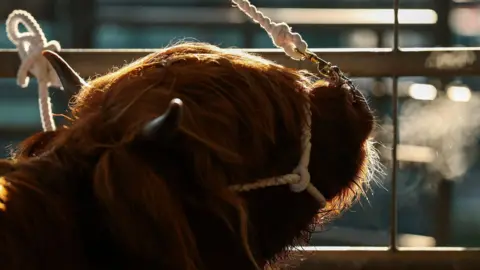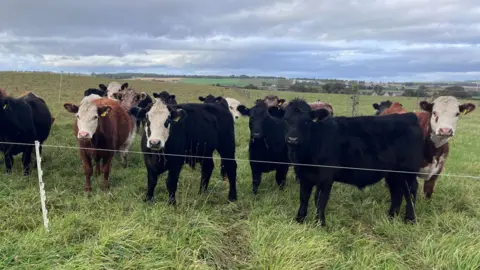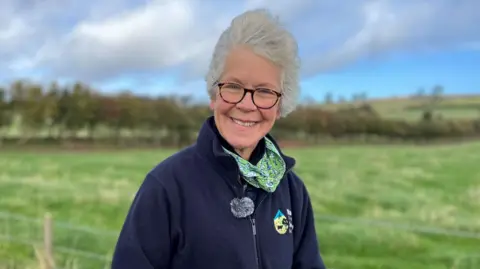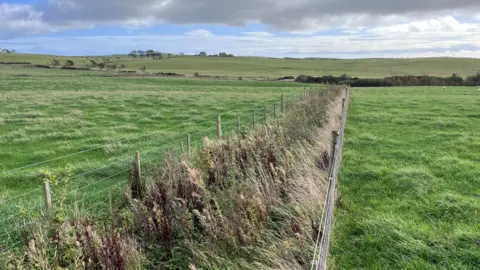Kevin KeaneEnvironment, energy and rural affairs correspondent, BBC Scotland
 BBC
BBCJohnnie Balfour farms a 300-strong herd of Aberdeen Angus – and is planning to expand operations.
Cattle are notoriously the most planet-warming, methane-emitting of all the farmed animals.
But Johnnie’s business, near Glenrothes in Fife, is rated as carbon negative – which means it removes more carbon dioxide from the atmosphere than it emits.
His grazing is efficient and emissions from the livestock are offset by trees, soils and grass on the land.
Unusually, Johnnie’s herd lives outdoors all-year-round through a process called mob grazing – where the cattle are shifted onto a fresh piece of grass every day.
He insists livestock should not be viewed as the problem for the environment, and that more focus should be placed on how farms as a whole are managed.
 Getty Images/Jeff J Mitchell
Getty Images/Jeff J MitchellHe said: “In our old system the cattle would have been spending quite a lot of time in the shed. When they’re in the shed they would have been eating some silage, barley and beans which would have been grown here.”
However, growing that feed would have involved sprays, fertiliser and “a lot of machinery”. These all have some kind of carbon footprint, but have now been cut from the process.
He believes cutting livestock numbers is too simplistic a way of tackling emissions in agriculture.
“It’s not the cow, it’s the how. We need to manage our cattle better,” he said.
Johnnie’s Aberdeen Angus cows are smaller than some of the continental breeds which can have a harsher impact on the land.
But his farming method demonstrates one way the Scottish government would like the land use sector to be operating by 2045.
Ministers have pledged to reach net zero – the point where we’re adding no more carbon dioxide to the atmosphere – by that date.
This is achieved mostly by cutting emissions. Those which remain are then offset through a combination of natural and engineered processes.
After repeatedly missing its annual targets, the Scottish government scrapped the measure last year in favour of five-yearly carbon budgets.

In the coming days, we expect to find out what Scotland plans to do to play its part in limiting global warming.
However, ministers have already blown a huge hole in how that can be achieved.
This summer, First Minister John Swinney promised farmers at the Royal Highland Show that they would not have to reduce livestock numbers.
That was quite the crowd pleaser on the day – but the policy comes with significant ramifications.
It goes against advice from the independent Climate Change Committee (CCC), which suggested cutting livestock by 26% by 2035.
Its report, Scotland’s Carbon Budgets, suggests annual emissions from agriculture should drop from 7.6 million tonnes in 2025 to 5.1 million by 2035.
The measures being suggested to reduce emissions include decarbonising machinery such as tractors and cutting fertiliser use.
The CCC report says 48% of that 2.5 million tonne cut in emissions should come from reducing livestock numbers.
That leaves a gap equal to about 1.2 million tonnes of planet-warming carbon dioxide by 2035.
Livestock numbers have been declining and are expected to fall further – but not at the rate needed to meet the CCC’s targets.
This is only one pathway towards achieving net-zero emissions by 2045, and the Scottish government does not have to follow the advice given to it by the CCC.
Planting more trees is one way to offset emissions.
The CCC’s suggested route to net-zero proposed increasing forestry cover from 19% of the land at present to 21% by 2035.
Part of the committee’s reasoning for reducing livestock numbers was to free up the land to create the new forests.
The government will need to identify where any additional trees can be planted.
However, tree planting has really stalled in recent years, with Scotland falling well short of its annual targets.
One nursery owner last year threatened to burn millions of young saplings after nature restoration budgets for tree planting were plundered to fund local authority pay rises.
There were warnings that disrupting growth in the tree planting sector for a short-term financial fix would set the industry back by years.
In September, the company Christies of Fochabers went into administration.
So ramping up afforestation – or tree planting – will not be an easy task.

One little-spoken-of alternative to tree planting involves extending the amount of hedgerows in Scotland’s countryside.
There are currently about 43,000km of managed and unmanaged hedgerows. The CCC proposes adding another 5,000km by 2035 and then 4,000km more in the following decade.
Denise Walton is a big advocate for the benefits hedgerows can bring to the land.
In recent years, she has added 11km to her farm in Berwickshire.
The holly, blackthorn, hazel and other native species provide corridors for wildlife as well as absorbing carbon dioxide from the atmosphere as they grow.
“On the canopy, on the top, you’ve got this wonderful foliage and then beneath the ground – what we can’t see – you’ve got a really impressive, intricate web of root mass which, working with the soil, is really what’s sequestering the carbon,” she said.

But when it comes to the amount of carbon which can be absorbed by hedgerows, the numbers aren’t great.
A study by Leeds University in 2022 found that increasing hedgerows by 40% would offset just 2.8% of England’s agricultural emissions.
Combined with agroforestry – where livestock is housed in fields where trees are planted – the Climate Change Committee concludes that the total offsetting potential in Scotland is 200,000 tonnes of carbon dioxide.
That’s well short of the 1.2 million tonne shortfall Scottish ministers have created for themselves.
What other options are available to the government?
In the short term, it could look to areas outside agriculture and land use to speed up emissions cuts.
Accelerating the rollout of electric vehicles would help.
Domestic transport is the biggest single source of Scotland’s greenhouse gas emissions, accounting for almost 29%. Agriculture ranks third, with just under 19%.
The current presumption is that 60% of cars on Scotland’s roads will be electric by 2035.
However, most of the levers for achieving that sit with the UK government – so a speedier transition just in Scotland therefore would seem unlikely.
More engineered removals would also help plug the gap. That would involve mechanically sucking carbon dioxide out of the atmosphere and burying it underground.
This technology is in its infancy and is really designed for offsetting areas such as aviation, where emissions cuts are difficult.
Ministers have caused themselves a predicament but the targets for cutting planet warming emissions are legally binding and they need to set out how they will achieve them.
The Climate Change Committee has previously been critical of plans which are vague on policies and light on detail.
So the government’s plan will have to be very specific about what needs to be achieved – and how.
Source link
 Unews World
Unews World

